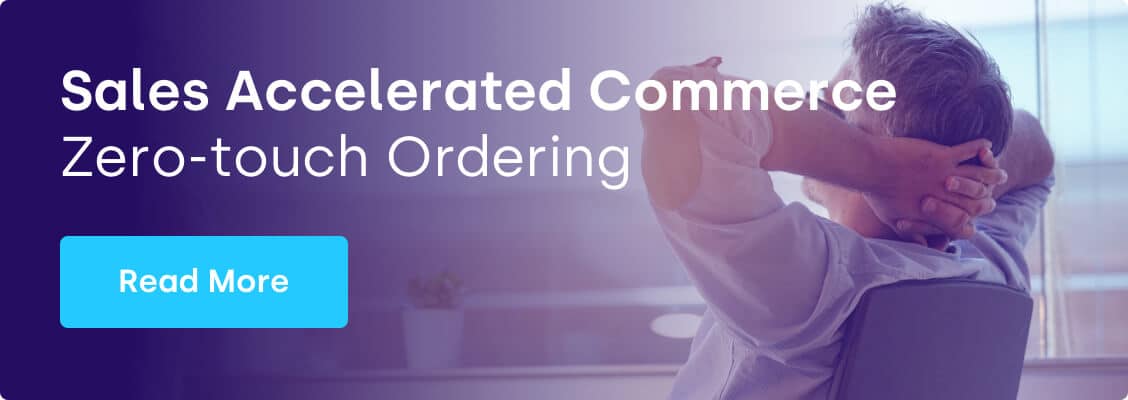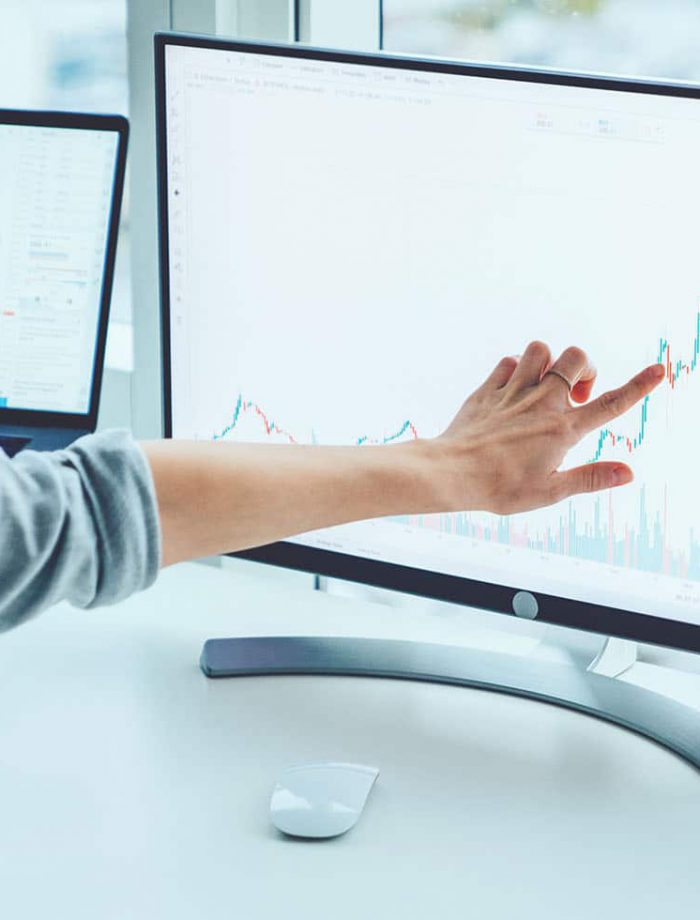One thing that all spare parts suppliers know for sure, is that the changes within B2B e-commerce are happening incredibly fast at present.
Naturally, spare parts often form a sideline for many manufacturing businesses. But in spite of this, it is good for turnover diversification, and all the more reason to keep a close eye on the latest developments.
Of course, change is nothing new. But what is new, is that everything is changing at the same time: customer requirements, end-customers, employees, suppliers, and of course technology, laws and regulations, the geopolitical situation – to name but a few.
And the division among these which is the biggest victim of all these changes? Sales!
In this blog you can read why that is the case, and why ‘zero-touch sales’ is presently the most logical way to work.
Why B2B sales still work in a fairly traditional way
Many B2B businesses that supply spare parts still work in a fairly traditional manner. That is to say, with inside sales, account managers, and the manual (sadly, often error-sensitive) processing of orders
This was still acceptable in 1999. But all the new developments that are taking place mean that a 1999-vintage sales operation represents a missed opportunity in 2021.
Of course, it is easy to say what doesn’t work. But what does work in 2021?
Zero-touch sales. That is the key concept now. And this isn’t just a slogan; it is pure necessity.
If you want to be able to deal with all the moving parts referred to above. Does this mean that you can say goodbye to all your sales personnel? No, but their role certainly needs to change.
Why is zero-touch ‘pure necessity’, what role should Sales focus on, and what role does technology play in this for spare parts suppliers?
If you are reading this as an employee, manager, or owner of a spare parts supplier, then you know how things work in your sales division.
But, for the sake of clarity, I will give a generalized summary, to show what we are aiming for.
This is why the traditional approach to sales is a missed opportunity for spare parts suppliers
Whether you know them as inside sales or back office, they sit in the office to accept and process orders.
In spite of the high error rate, that worked OK around 1999 (and earlier) because fully automated input and processing were not or were barely available for a typical wholesaler or manufacturing business.
Yes, the internet existed, but at that time relatively fast connections were not as widespread (or affordable) as now; dial-up connections were still the standard.
Yes, there were webshops, but they were relatively expensive to create and to manage.
The same was true of an ERP if you had the benefit of scale (and capital). But if you wanted to connect all the processes together, you could expect to pay dearly for all the hardware and software required. That, together with years of paid upgrades and training in order to still have to work with cumbersome software packages. Furthermore, offline shopping was the norm, so why invest in immature channels?
Yes, there was multitenant SaaS for B2B, but in 1999 (the year that textbook example Salesforce was founded) that was no longer something for innovators.
The same thing was true of the mobile internet. That existed, but both 2G and the telephones themselves were not the best way to be really productive – other than for sending messages. The devices that passed for smartphones in the business world were actually above all PDA’s such as those from Palm and BlackBerry.
Put briefly, all the technologies were present, but not yet mature enough for today’s zero-touch sales.
Things are certainly different in 2021
Where fixed internet isn’t fast enough, luckily the worldwide mobile standard 4G goes further, to say nothing of the much faster sounding 5G which is now being rolled out.
And we now have very powerful mobile devices with user-friendly interfaces. It doesn’t matter where you work; you can work anywhere with all the tools you need via the browser or a mobile app.
User-friendly multitenant SaaS with built-in Machine Learning is the norm; including for old providers of ERP software such as Exact, SAP, or Microsoft that became big in the 1980s.
Even an average consumer can set up a webshop in a few minutes and start importing from China. And, thanks to drop-shipping, a big warehouse is no longer necessary.
The point of this short history lesson?
Imagine if you were able to travel back in time to 1999, pick up a customer there and bring them to 2021.
That customer would hardly believe their eyes: self-propelled and even flying cars, smartphones that vastly out-perform the average content of a server cupboard from 1999, the success of Netflix, Spotify, Coolblue, Bol.com, the domination of Apple, Amazon, Facebook & Google, and so on, and so forth – 2021 is a completely different world in virtually every aspect.
So why would you do want to go back in time? Why use an old standard for customers, consumers, and suppliers who live in this world, that is 20 years further ahead in technology and culture.
In other words, why would you want to carry on working manually?
Because that is what often happens. Even though accepting orders, checking them against the real-time inventory that you or your suppliers are holding, making an offer, following through, packing, shipping, invoicing, obtaining payment and processing in the bookkeeping have all been fully automated; something that we call zero-touch sales.
For years now.
Today’s customers have now become used to contactless online ordering and payment. They want to configure everything for themselves. They have neither the time nor the inclination to wait until office hours, have to work their way through a call menu and then hope that the sales rep has taken good note of everything.
Of course, emailing is also possible. But that soon becomes a muddle of mails back and forth, with so many asides that everyone in the thread has soon lost the plot. And that is just the beginning; because then the inside sales team has to pass on the order… via email.
The error rate in this process is so high because there are so many moving parts. And there is not a single spare parts supplier on earth who can afford to have an error-sensitive, cumbersome, and unnecessarily expensive traditional sales, and order system. Today’s competition is simply too fierce and margins continue to shrink.
So, recording and processing orders is a terrible waste of the time and talent of your inside sales team; they will be able to show their true worth with actual sales.
So, allow them to help the account managers to find and bring in new prospects or to explore upsell or cross-sell opportunities among customers. Once added to the customer list they are often forgotten, even though enthusiastic, contented customers are the best references for your business.
Thanks to zero-touch sales you can link all your processes, customers and suppliers together securely. Customers benefit from extremely fast 24/7 online ordering via a webshop with a real-time inventory counter and all the product info they need. Regardless of what type of device they happen to be working with.
Suppliers only need to deliver the actual orders, so that both of you can optimize the inventory level in your warehouses. That is good for your working capital and available warehouse space.
In other words: happy sales, 24/7 faultless selling to contented customers, collaborating with streamlined suppliers by deploying today’s affordable technology in a smart manner.
If you would like more information about how you can organize your sales team following automation with zero-touch sales, then we recommend you to read the next article.
What does your B2B sales team still do, after the digital transformation?
The digitalization of your order processes has many advantages. Ease of ordering for your customers, improved margins due to smarter (automatic) buying. But it also has an impact on your sales team. In this article, I would like to show you what impact the digital transformation of our clients has on their sales teams.
Most B2B businesses have an internal and an external sales team: the inside sales and the account managers. If you ask how much time they spend actually selling, you get the same answer: not enough.
How do you know if your company is ready for the next level in B2B e-commerce?
The aim is that in the end, you will have a comprehensive digital ecosystem that offers all your customers their own user experience. This means that multiple systems are linked together in the back-end, in order to achieve that ambition level.
But how do you know whether your business and online platform are ready to think and to be organized on the basis of one single platform? How do you know whether you are ready for one-platform e-commerce, with a customer portal that offers the ultimate user experience?
These 5 questions will help you to evaluate whether you are ready for one-platform e-commerce.
- Are the offline sales processes already linked to online sales?
- How often does a tailored quotation pass backward and forwards between the account manager and customer?
- How much time does the account manager actually spend on quotations?
- How often does an upsell take place?
- If you look at your existing systems, such as your ERP and PIM, what works and what doesn’t work?
In brief: as a manufacturer, are you ready for the next level? Yes?
Discover the boundless ease of zero-touch sales.






